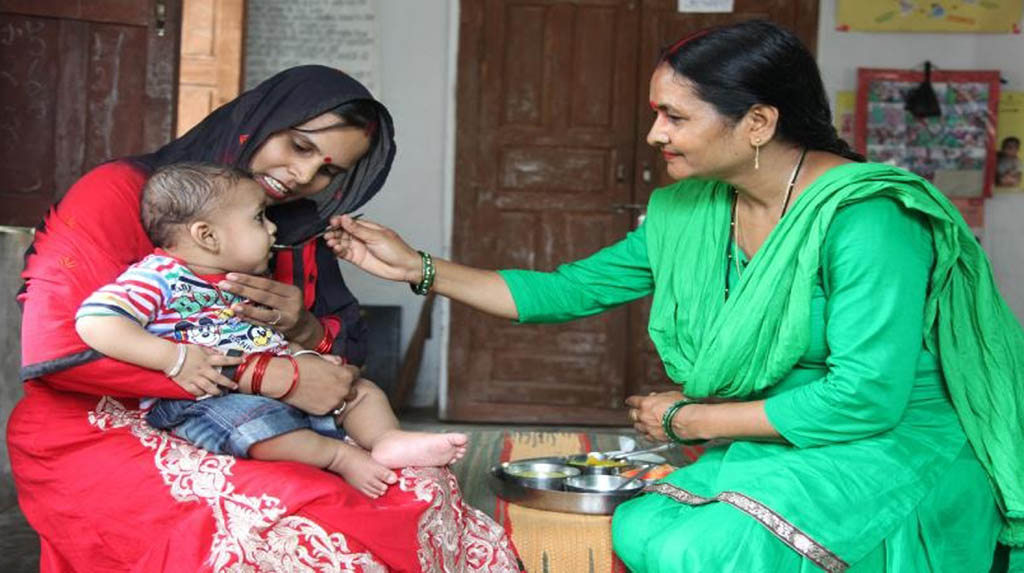New Delhi: Indias public health and nutrition efforts are differentiated by an enterprising early start going as far back as 1975 with the beginning of Anganwadi centres and Integrated Child Development Services (ICDS). Lauding this strong, continued focus on maternal and child nutrition, experts specialising in India’s nutrition space prescribe integration of three key factors like quality of services, convergence of healthcare services at the household level, and strategic use of data at various levels to improve program implementation, that could further advance public nutrition service delivery in India.
Committed to a malnutrition-free India, the country’s robust public health and nutrition infrastructure has positioned dedicated frontline workers as its pillars, making it one of the few countries to achieve this scale and intensity of human resource support. For every 1000 population, there is one Accredited Social Health Activist (ASHA), one Anganwadi Worker (AWW) and one Anganwadi helper, and one Auxiliary Nurse Midwife (ANM) for approximately every 5000 population. Under the Poshan Abhiyaan, key public programs and outreach schemes make nutrition-based interventions to lift nutritional well-being for all.
“India has a well-funded program for various nutrition-specific and sensitive interventions covering the entire country. During the POSHAN Maah (Nutrition Month) there was reiteration to continue focusing on the basics of prevention of maternal and child undernutrition and focus was also brought on new areas, such as children with Severe Acute Malnutrition (SAM) and promotion of locally-sourced nutrient-rich foods grown in kitchen gardens. Food fortification, too, has gained good momentum in India over the last few years. I feel a larger number has been added to the people consuming fortified products in the world from India, than any other country in the last few years. India has almost everything (policies, human resource, funding and political will) in place in terms of what needs to be driven and the focus now more than ever before has to be on strengthening the implementation,” shares Dr Alok Ranjan, Country Lead (Nutrition), Bill and Melinda Gates Foundation.
Setting foundations of health and cognitive development in a child, the first 1000 days (from pregnancy to first two years of life) are often neglected, visible in the abysmally low levels of minimum adequate diet received by children between 6-23 months of age, as shown by the 2016-18 Comprehensive National Nutrition Survey (CNNS). Failure to nourish the mother-child dyad in accordance with the five components of Poshan — the child’s first 1000 days, anaemia prevention, diarrhoea management, nutritional foods and WASH (water, sanitisation and hygiene) — can set back the healthy physical and cognitive development of a child. At the macro level, undernutrition impairs public health levels and the future of a nation.
Highlighting the multi-sectoral aspect of nutrition, Dr Ranjan builds on his experience like the Polio, Routine Immunization and Vitamin A supplementation work in states like Bihar and Uttar Pradesh, and points out that the nutrition program implementation can borrow few key factors from successful public health programs like polio, routine immunization and vitamin-A that could aid transforming India’s nutrition landscape – such as improving the quality of services and using data for improving program implementation, along with ensuring the convergence of service delivery for the core target of mother and child.
“In the maternal and child health program, globally as well as in India, quality of intervention is already a priority focus area. There’s no similar momentum around quality of nutritional intervention globally or in India. As the coverage numbers are increasing with the Poshan Abhiyaan, we need to start looking at it, right from the quality of training frontline workers, to quality in food supplementation as well as quality of the counselling sessions at anganwadi centers or during home visits. Thus, focus on improving the quality at all levels would go a long way in helping us achieve our nutrition targets,” says Dr Ranjan. As an instance, the expert points to ensuring quality of counseling the mother receives, from the day her registration is done under both Health and ICDS systems for various Antenatal services.
“Community and household counselling, if not done properly, will not lead to the kind of impact we are aiming for. For instance, if iron and folic acid (IFA) supplementation tablets have been made available till the last mile in a village and are distributed to pregnant women then they must also be counselled adequately around how and when to consume those tablets, what side effects they should be aware of, what is the benefit of these tablets for them and their next generation. Just the way we expect focused and detailed counselling when we take any of our family members to a private practitioner, similarly in the public health setup, just ensuring supply is not enough. Counselling with time and quality can have a profound impact,” he shared.
According to Thomas Forissier, Director Programs, South Asia, Alive & Thrive (FHI 360), increasing the coverage of nutrition-related services and benefits is often the first step, but increasing the coverage of high quality services and benefits is the necessary second step.
“There is no alignment on a simple definition of quality. Most experts would agree that quality involves the right inputs: infrastructure, training of frontline workers, commodities, etc.; the right processes: providing key advice to families on how to nourish pregnant women and children, weight and height measurements, provision of various foods and micronutrients, etc.; and the right outputs: starting with client satisfaction. But none of those experts are likely to agree today on how all of those items fit together, which ones are more important. It is critical for the nutrition community to define what is the quality of nutrition services and benefits and how to measure it as soon as possible. And then to start using those measures in the field,” says Thomas Forissier.
Dr Ranjan also emphasises on strategic use of data, such as data from supervisor’s field visit, regular MIS systems of various departments, national surveys like National Family Health Survey etc. and to use these data for identifying actionable next steps at various levels like at national, state, district, project, village and household level. Also given the fact that most of the nutrition focused messaging is around behaviour change (like breastfeeding, diet diversity, IFA consumption etc) it is important to go beyond one-time messaging for high impact and effective social-behavioural change. “The same messaging needs to be delivered repeatedly to the household, through all touchpoints – mass media, radio, advertisements, local newspapers, self-help groups, opinion leaders, Anganwadi workers, helpers, ASHAs, and ANMs.”
For convergence of health and nutrition services at the household level for the mother-child, Dr Ranjan suggests the dyad should get easy access to services like including immunisation, take-home ration, PDS ration, IFA tablets, safe drinking water, proper hygiene, counseling on maternal diet and best feeding practices, during the golden 1000-day window of opportunity (from conception to her second birthday). “For improved nutritional status and to meet Sustainable Development Goal 2: �Zero Hunger’, it is crucial to converge all efforts at the household level. The convergence action plans at national, state, district, block and even community levels, must put convergence at the household level of all mother-child nutrition services at the centre of these plans. If we do all this with quality, we’d have an accelerated improvement in the nutrition indicators and reduction in undernutrition.”
“Convergence of services starts to matter when you look at it from the perspective of households. Did they get all the nutrition-related services and benefits that they are eligible for? Did they get antenatal care services from health, take-home rations from ICDS, nutrition counseling from both, food from the PDS, employment benefits from MNREGA, IFA from Health or at school? Do they have running water and hygiene facilities? Today, few families get the full set of nutrition-related services and benefits they should receive. The only way to change that is to stop thinking about services, and start thinking about families. In mature states, measuring and acting on household convergence should be prioritized at all administrative levels. In less advanced states, involving Panchayat Raj Institutions or other groups to drive accountability of the system to collectively service individual families is a good start,” opines Dr Forissier.
Another expert, Dr Shailesh Jagtap, Senior Technical and Program Advisor with Alive & Thrive, concurs that a paradigm shift on use of data for decision making for systems improvement at each level of system, would be a game changer.
“There is an important saying that – that which gets measured gets implemented. There was a time when data on nutrition was scarce and now with investments in POSHAN Abhiyaan we are moving towards abundance. Administrative data from ICDS and Health departments presents real time data on POSHAN Abhiyaan program interventions and HMIS (Health Management Information System) from the health department having nutrition indicators provides an opportunity for improving the nutrition program service delivery. Apart from the routine data collection systems which focuses on outcome data it is important to have data on the quality components of service provision through regular Quality Assessments of the POSHAN Abhiyan program which provide valuable insight for service delivery improvements. The system now needs to gear up on how this data is being used,” Dr Jagtap shares.
Under the �POSHAN Ke 5 Sutra’, the focus has been on the absolute critical components for prevention of undernutrition. And one cannot overemphasize the need to prevent mother and child from getting undernourished, because once they become undernourished we will always be busy treating them rather than fixing the problems that led them to become undernourished in the first place. Unless we fix those underlying factors mother and child will continue becoming undernourished. Giving the example of an open tap, our first focus has to be to close the tap first (prevent mother and children from becoming undernourished) or else we will keep mopping the floor for years to come (keep treating those who have become undernourished) as more and more mother and child will keep getting undernourished unless we prevent them from getting to that stage, concludes Dr Ranjan of BMGF.




